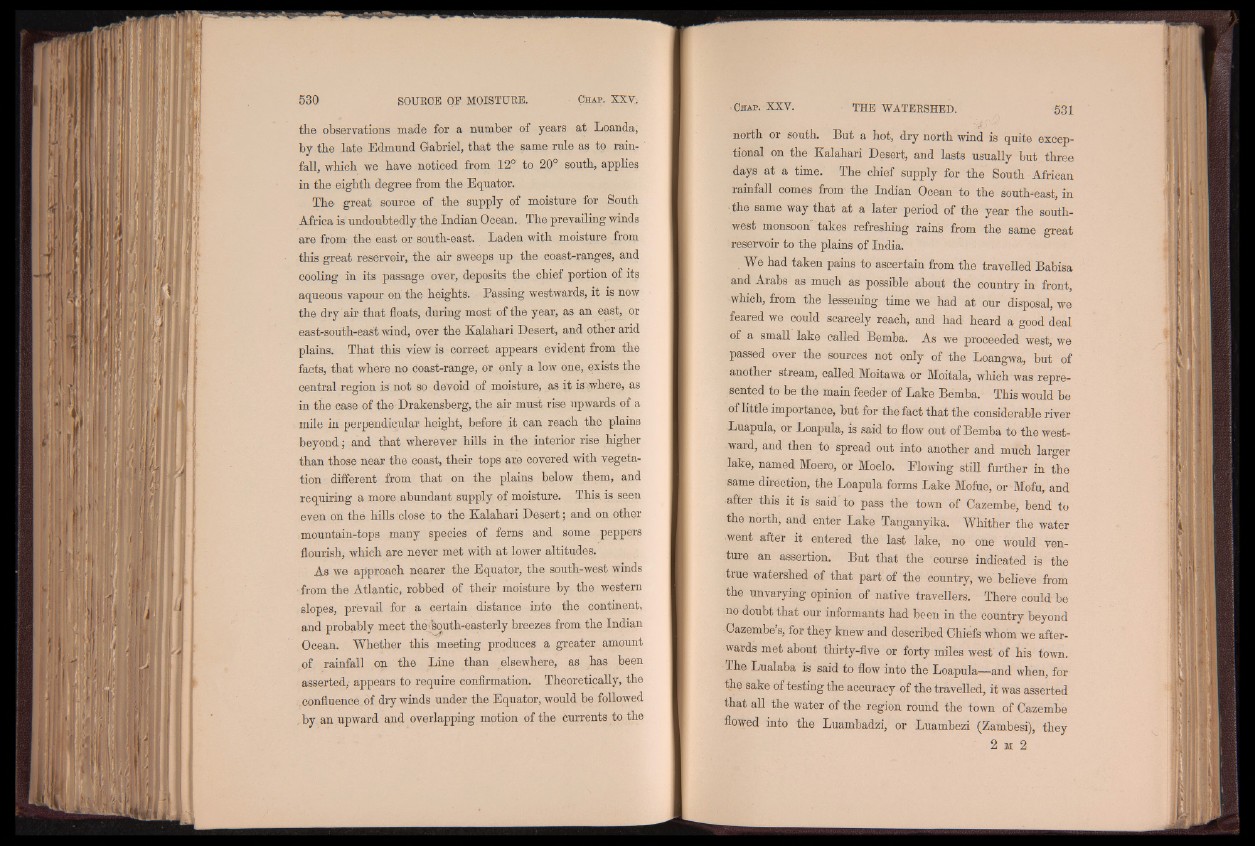
the observations made for a number of years at Loanda,
by the late Edmund Gabriel, that the same rule as to rainfall,
which we have noticed from 12° to 20° south, applies
in the eighth degree from the Equator.
The great source of the supply of moisture for South
Africa is undoubtedly the Indian Ocean. The prevailing winds
are from the east or south-east. Laden with moisture from
this great reservoir, the air sweeps up the coast-ranges, and
cooling in its passage over, deposits the chief portion of its
aqueous vapour on the heights. Passing westwards, it is now
the dry air that floats, during most of the year, as an east, or
east-south-east wind, over the Kalahari Desert, and other arid
plains. That this view is correct appears evident from the
facts, that where no coast-range, or only a low one, exists the
central region is not so devoid of moisture, as it is where, as
in the case of the Drakensberg, the air must rise upwards of a
mile in perpendicular height, before it can reach the plains
beyond; and that wherever hills in the interior rise higher
than those near the coast, their tops are covered with vegetation
different from that on the plains below them, and
requiring a more abundant supply of moisture. This is seen
even on thé hills close to the Kalahari Desert; and on other
mountain-tops many species of ferns and some peppers
flourish, which are never met with at lower altitudes.
As we approach nearer the Equator, the south-west winds
from the Atlantic, robbed of their moisture by the western
slopes, prevail for a certain distance into the continent,
and probably meet the • south-easterly breezes from the Indian
Ocean. Whether this meeting produces a greater amount
of rainfall on the Line than elsewhere, as has been
asserted, appears to require confirmation. Theoretically, the
confluence of dry winds under the Equator, would be followed
by an upward and overlapping motion of the currents to the
north or south. But a hot, dry north wind is quite exceptional
on the Kalahari Desert, and lasts usually but three
days at a time. The chief supply for the South African
rainfall comes from the Indian Ocean to the south-east, in
the same way that at a later period of the year the southwest
monsoon takes refreshing rains from the same great
reservoir to the plains of India.
We had taken pains to ascertain from the travelled Babisa
and Arabs as much as possible about the country in front,
which, from the lessening time we had at our disposal, we
feared we could scarcely reach, and had heard a good deal
of a small lake called Bemba. As we proceeded west, we
passed over the sources not only of the Loangwa, but of
another stream, called Moitawa or l\foitala, which was represented
to be the main feeder of Lake Bemba. This would be
of little importance, but for the fact that the considerable river
Luapula, or Loapula, is said to flow out of Bemba to the westward,
and then to spread out into another and much larger
lake, named Moero, or Moelo. Blowing still further in the
same direction, the Loapula forms Lake Mofue, or Mofu, and
after this it is said to pass the town of Cazembe, bend to
the north, and enter Lake Tanganyika. Whither the water
went after it entered the last lake, no one would venture
an assertion. But that the course indicated is the
true watershed of that part of the country, we believe from
the unvarying opinion of native travellers. There could be
no doubt that our informants had been in the country beyond
Cazembe’s, for they knew and described Chiefs whom we afterwards
met about thirty-five or forty miles west of his town.
The Lualaba is said to flow into the Loapula—and when, for
the sake of testing the accuracy of the travelled, it was asserted
that all the water of the region round the town of Cazembe
flowed into the Luambadzi, or Luambezi (Zambesi), they
2 m 2